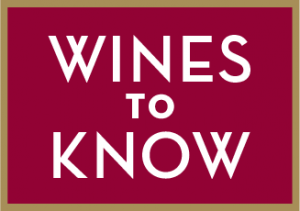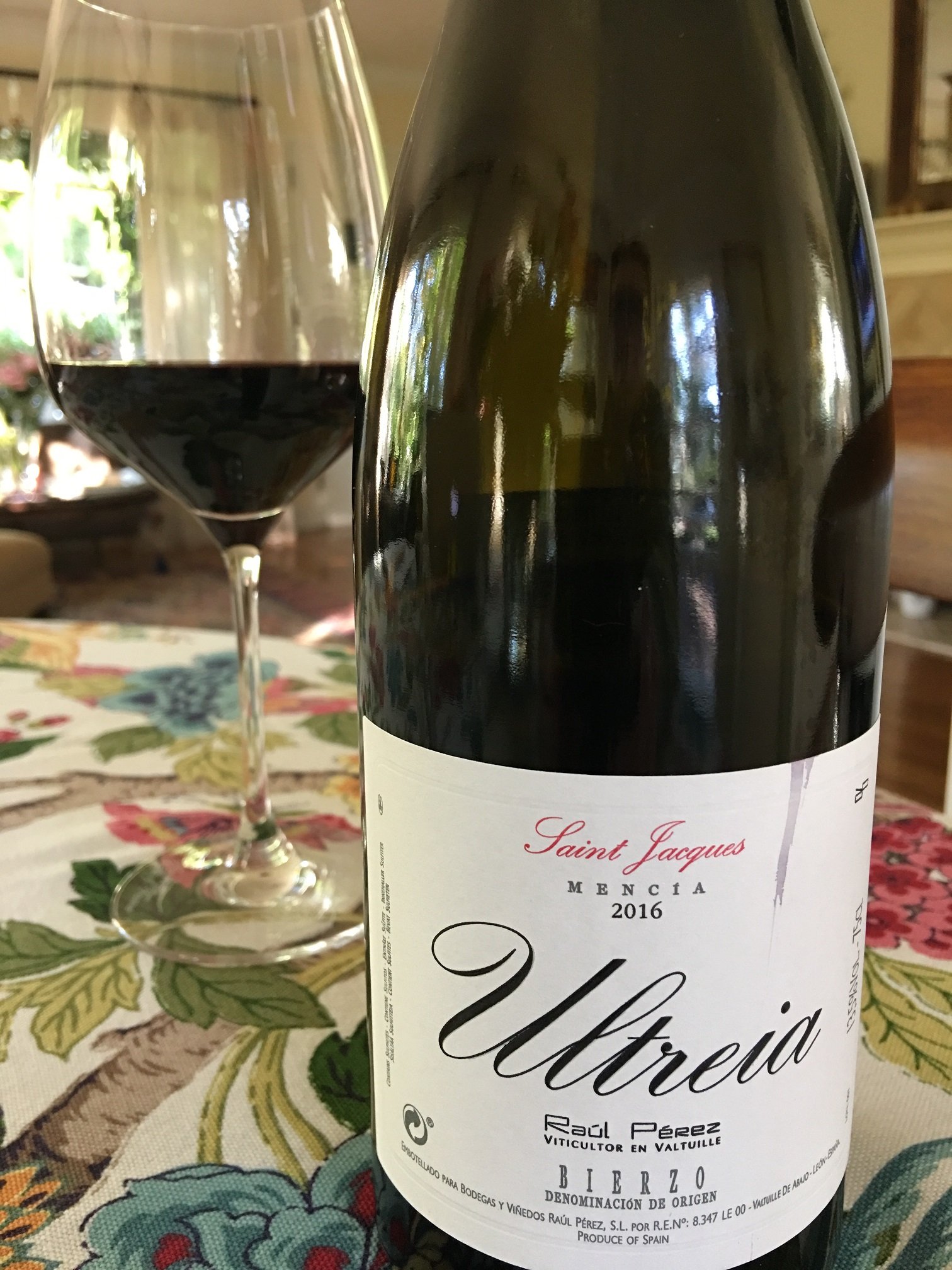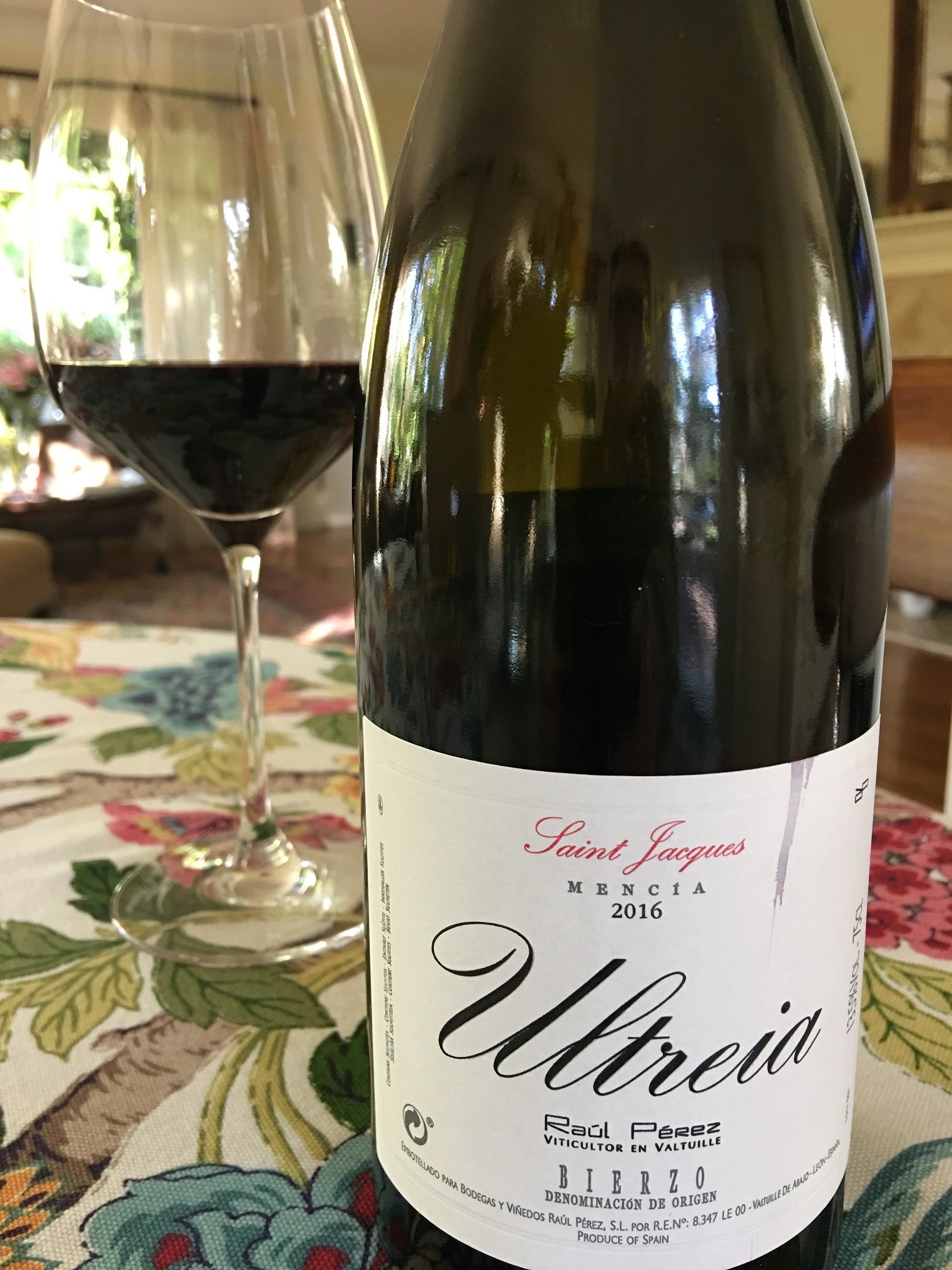
Raúl Pérez | “Ultreia St. Jacques” Mencia 2016
(Bierzo, Spain) $18
 If you’ve never tried the red grape variety mencia, take your first plunge with Ultreia (pronounced as ul-TRAY-ya) St. Jacques from Raúl Pérez. It’s a fascinating wine—sleek yet rustic, fruity yet sophisticated, vivid in flavor, but not ponderous. Plus, the best mencias, like this one, have a whoosh of spice. Finding such full-throttle deliciousness in a wine that costs less than $25 is, well, a gift. Ultreia comes from 75-year-old vines in Bierzo, a mountainous part of northern Spain. It’s a perfect summer red. (13.5% abv)
If you’ve never tried the red grape variety mencia, take your first plunge with Ultreia (pronounced as ul-TRAY-ya) St. Jacques from Raúl Pérez. It’s a fascinating wine—sleek yet rustic, fruity yet sophisticated, vivid in flavor, but not ponderous. Plus, the best mencias, like this one, have a whoosh of spice. Finding such full-throttle deliciousness in a wine that costs less than $25 is, well, a gift. Ultreia comes from 75-year-old vines in Bierzo, a mountainous part of northern Spain. It’s a perfect summer red. (13.5% abv)
91 points KM
Available at K&L Wine Merchants

Where is the wine region of Willcox located?
A. On the north island of New Zealand
B. In western Virginia
C. On the “downs” of southern England
D. In the southeast corner of Arizona

Bloody Hell, College Was Brutal
Alas, it wasn’t this way for me (or you either probably) but in England historically, wine—and especially Port—played a notable part in college life. According to the Rare Wine Company (an importer/retailer specializing in Port and Madeira) in the early part of the nineteenth century, important universities like Cambridge and Oxford had breathtakingly enormous wine cellars, and there was ten times as much Port in those cellars than any other wine. Far from being a mere hedonistic indulgence, Port was “currency”—often used by students to pay off wages, bets, and fines.


“Drinking good wine with good food in good company is one of life’s most civilized pleasures.”
―Michael Broadbent, English critic

Should Wine and Food Get Divorced?
Since its origin approximately 8,000 years ago, wine has always had a constant companion: food. For most of European history, little distinction was drawn between the two. Wine was food. It was as intimate a part of life as breathing.
But we’ve arrived at a very different time. For decades now, the intentional pairing of food and wine—how to do it; how to do it perfectly—has been given much print.
Does it deserve to? Continue Reading…


Adventurous wines for adventurous people
TABLAS CREEK “Patelin de Tablas” Rosé 2017 (Paso Robles, California) $25
There are a lot of light rosés on the market. This isn’t one of them. This is the sort of old fashioned, spicy, bold, dramatic rosé they drink in the south of Europe with bouillabaisse, gazpacho, and other garlic-laced dishes. Garlic can make many wines go anemic. Not this number.
JEFFERSON VINEYARDS Viognier 2016 (Charlottesville, Virginia) $30
Lovely and fresh with just the right edge of delicious bitterness. Thomas Jefferson would have been proud.
BEAUMONT FAMILY WINES Pinotage 2014 (Bot River, South Africa) $35
Rustic and really tasty. Hide the label and serve with BBQ on July 4th and watch your friends be stumped.

These words in these countries all mean the same thing: Alte Reben (Germany), Vinas Viejas (Spain), and Antico Vitigno (Italy).
Answer: True. Old vines are treasured everywhere in the world—so much so that the term “old vines” is often printed right on the label. As a vine ages, it becomes very well adapted to its environment. It learns not to expend energy forming unnecessary leaves or shoots. And rather than producing dozens of clusters of grapes, it focuses on just a few that it can ripen perfectly. Interestingly, what makes an old vine old is not regulated or defined by law. That said, most top producers in the world consider a vine to be old once it’s over 40 years old.








